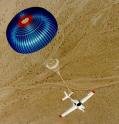The Right Brothers

The other day I had my first small plane experience. I have flown eight-seaters and sixteen-seaters into islands and small airports and such but I had never before flown in a truly small plane.
The plane was new. A four-seat Cirrus prop plane, built in the town I was born,
This is unless you land in water, on a house, a busy freeway or other such formidable landscape. But nonetheless, the parachute is and was comforting.
The morning of the last flight on this particular trip, we took off from
The first sense of trouble came during an approach to
The pilot informed the control tower of our re-route to our end destination; Palo-Alto airport. We skirted the edge of the storm and proceeded up the valley toward
The stall speed on this small aircraft is 60 knots. The maximum flap speed 120 knots. As we were flying over
This was my first week on my new job. The pilot was my new boss. I started to really worry as he called for an unscheduled landing at San Jose International airport, amongst all the big jets. He told the control tower we were experiencing severe wind shear during his explanatory conversation with the tower.
We landed safely and later he told me that was the scariest flight he had ever flown. He’s 48 years old and he obtained his pilots license at age 17…
Following are the most recent statistics for small aircraft accidents from the NTSB :
Accidents Aircraft Hours Flown
Year Major Serious (millions)
2000 3 3 18.299
2001 5 1 17.752
2002 1 1 18.012
Definitions of NTSB Classifications
Major - an accident in which any of three conditions is met:
- a Part 121 aircraft was destroyed, or
- there were multiple fatalities, or
- there was one fatality and a Part 121 aircraft was substantially damaged.
Serious - an accident in which at least one of two conditions is met:
- there was one fatality without substantial damage to a Part 121 aircraft, or
- there was at least one serious injury and a Part 121 aircraft was substantially damaged.

0 Comments:
Post a Comment
<< Home